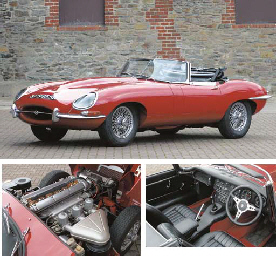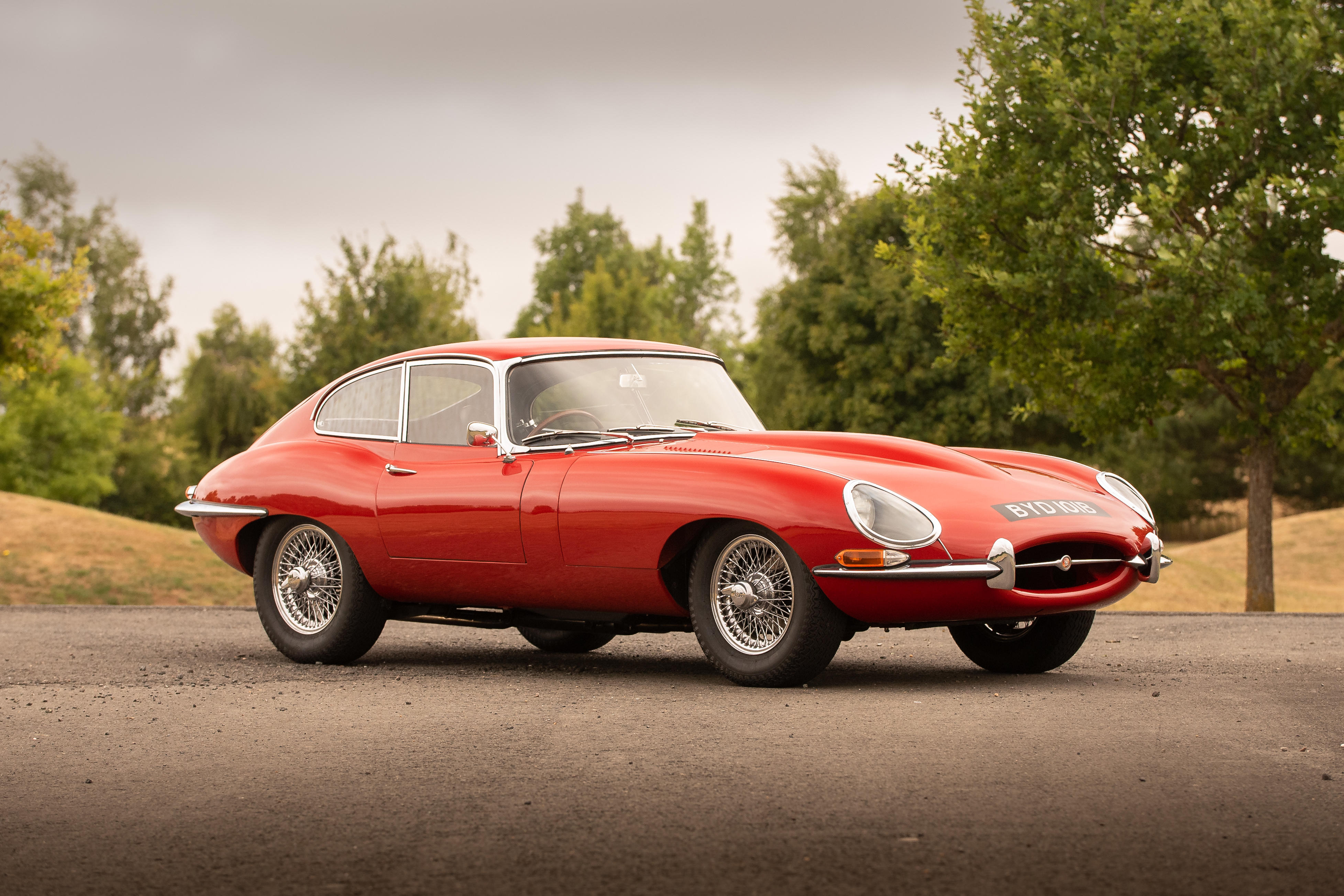1965 Jaguar E-Type Series 1 Semi-Lightweight Lot Number311 RegistrationFAD 234C Chassis NumberIE 20883 Engine Number7E5309-9 Odometer reading6,436 miles Estimate£95,000 - £135,000 ResultSold - £134,400 Print details Send this to a friend 11 more images Number six of 10 Zealia Lightweight examples Numbers matching example recently featured on Pistonheads Built and finished by Brian Wilkinson in homage to 4 WPD Previous Best in Class concours winner The elevation of the GT class to Manufacturers’ Championship status for 1963 prompted Jaguar to develop a small batch of very special lightweight cars to challenge Ferrari. The FIA’s regulations for the Gran Turismo category stipulated that a minimum of 100 cars had to be built, but permitted coachwork modifications, thus enabling Jaguar to claim that its lightweights were standard E-Types fitted with altered bodywork – the same loophole exploited by Ferrari to get the limited edition 250 GTO homologated, by claiming that they were rebodied 250 GTs. In fact, all 12 lightweight E-Types constructed in that period were built from scratch with aluminium bodies, though they were invoiced as a new standard road car with additional modifications and numbered in the normal production sequence, albeit with an S chassis number prefix. To create the 1963 lightweight version, the E-Type’s steel monocoque tub and outer body panels were remanufactured in aluminium and the engine dry-sumped and fitted with an alloy cylinder block, wide-angle head and Lucas mechanical fuel injection, producing in excess of 300bhp. The production four-speed gearbox was used initially before a ZF five-speed unit was adopted towards the end of 1963. ‘4 WPD’, the works development E-Type racer campaigned by John Coombs and driven by Graham Hill, was converted to lightweight specification, and served as the prototype. The 12 cars built by the factory were intended for the use of competition orientated Jaguar dealers or specially selected private entrants. Today, modern interpretations of these rare competition variants are among the most popular and sought after of all E-Types. Zealia Engineering was created by Brian Wilkinson, a Kiwi who flew over from New Zealand and worked in the Formula One pits with none other than Bruce McLaren, he joined up alongside John Aley and they together eventually invented the ‘roll over bar’ or the ‘roll-bar’ as we know it today. Brian later went on to set up his Safety Devices company for which he was honoured by Cambridge University. After this successes he later went on to create Zealia Engineering where he produced some of the best semi-lightweight E-Types known to connoisseurs, collectors and enthusiasts alike, these were recognised as true masterclass in engineering and highly regarded. To recreate his work today it’s estimated it would cost in excess of £200,000, so to be a custodian of his work is truly a privilege. This beautiful matching numbers UK delivered example has been subject to a nut and bolt rebuild to semi-lightweight specification, which was completed to a very high standard. It was recently featured by Pistonheads for which a copy of the article can be found in the history file. The body was rebuilt and finished by Brian Wilkinson of Zealia Engineering, very well-known and highly regarded for his accurate recreations of the factory Lightweight cars. One of just ten cars, during the build the doors, boot, bonnet and roof were replaced with lightweight aluminium items, and both side and rear windows replaced with Perspex screens. As in period, the correct air vents were added to the roof and boot, and the wheel arches extended with correct extensions as per Le Mans regulations. Finally, aluminium bucket seats, clad in period-correct blue leather, were fitted to the interior, whilst a set of magnesium knock-off wheels complete the exterior of the car. Mechanically the E-Type enjoyed many race-orientated upgrades. Notably the original 4.2 litre motor was fully rebuilt a
1965 Jaguar E-Type Series 1 Semi-Lightweight Lot Number311 RegistrationFAD 234C Chassis NumberIE 20883 Engine Number7E5309-9 Odometer reading6,436 miles Estimate£95,000 - £135,000 ResultSold - £134,400 Print details Send this to a friend 11 more images Number six of 10 Zealia Lightweight examples Numbers matching example recently featured on Pistonheads Built and finished by Brian Wilkinson in homage to 4 WPD Previous Best in Class concours winner The elevation of the GT class to Manufacturers’ Championship status for 1963 prompted Jaguar to develop a small batch of very special lightweight cars to challenge Ferrari. The FIA’s regulations for the Gran Turismo category stipulated that a minimum of 100 cars had to be built, but permitted coachwork modifications, thus enabling Jaguar to claim that its lightweights were standard E-Types fitted with altered bodywork – the same loophole exploited by Ferrari to get the limited edition 250 GTO homologated, by claiming that they were rebodied 250 GTs. In fact, all 12 lightweight E-Types constructed in that period were built from scratch with aluminium bodies, though they were invoiced as a new standard road car with additional modifications and numbered in the normal production sequence, albeit with an S chassis number prefix. To create the 1963 lightweight version, the E-Type’s steel monocoque tub and outer body panels were remanufactured in aluminium and the engine dry-sumped and fitted with an alloy cylinder block, wide-angle head and Lucas mechanical fuel injection, producing in excess of 300bhp. The production four-speed gearbox was used initially before a ZF five-speed unit was adopted towards the end of 1963. ‘4 WPD’, the works development E-Type racer campaigned by John Coombs and driven by Graham Hill, was converted to lightweight specification, and served as the prototype. The 12 cars built by the factory were intended for the use of competition orientated Jaguar dealers or specially selected private entrants. Today, modern interpretations of these rare competition variants are among the most popular and sought after of all E-Types. Zealia Engineering was created by Brian Wilkinson, a Kiwi who flew over from New Zealand and worked in the Formula One pits with none other than Bruce McLaren, he joined up alongside John Aley and they together eventually invented the ‘roll over bar’ or the ‘roll-bar’ as we know it today. Brian later went on to set up his Safety Devices company for which he was honoured by Cambridge University. After this successes he later went on to create Zealia Engineering where he produced some of the best semi-lightweight E-Types known to connoisseurs, collectors and enthusiasts alike, these were recognised as true masterclass in engineering and highly regarded. To recreate his work today it’s estimated it would cost in excess of £200,000, so to be a custodian of his work is truly a privilege. This beautiful matching numbers UK delivered example has been subject to a nut and bolt rebuild to semi-lightweight specification, which was completed to a very high standard. It was recently featured by Pistonheads for which a copy of the article can be found in the history file. The body was rebuilt and finished by Brian Wilkinson of Zealia Engineering, very well-known and highly regarded for his accurate recreations of the factory Lightweight cars. One of just ten cars, during the build the doors, boot, bonnet and roof were replaced with lightweight aluminium items, and both side and rear windows replaced with Perspex screens. As in period, the correct air vents were added to the roof and boot, and the wheel arches extended with correct extensions as per Le Mans regulations. Finally, aluminium bucket seats, clad in period-correct blue leather, were fitted to the interior, whilst a set of magnesium knock-off wheels complete the exterior of the car. Mechanically the E-Type enjoyed many race-orientated upgrades. Notably the original 4.2 litre motor was fully rebuilt a















Testen Sie LotSearch und seine Premium-Features 7 Tage - ohne Kosten!
Lassen Sie sich automatisch über neue Objekte in kommenden Auktionen benachrichtigen.
Suchauftrag anlegen